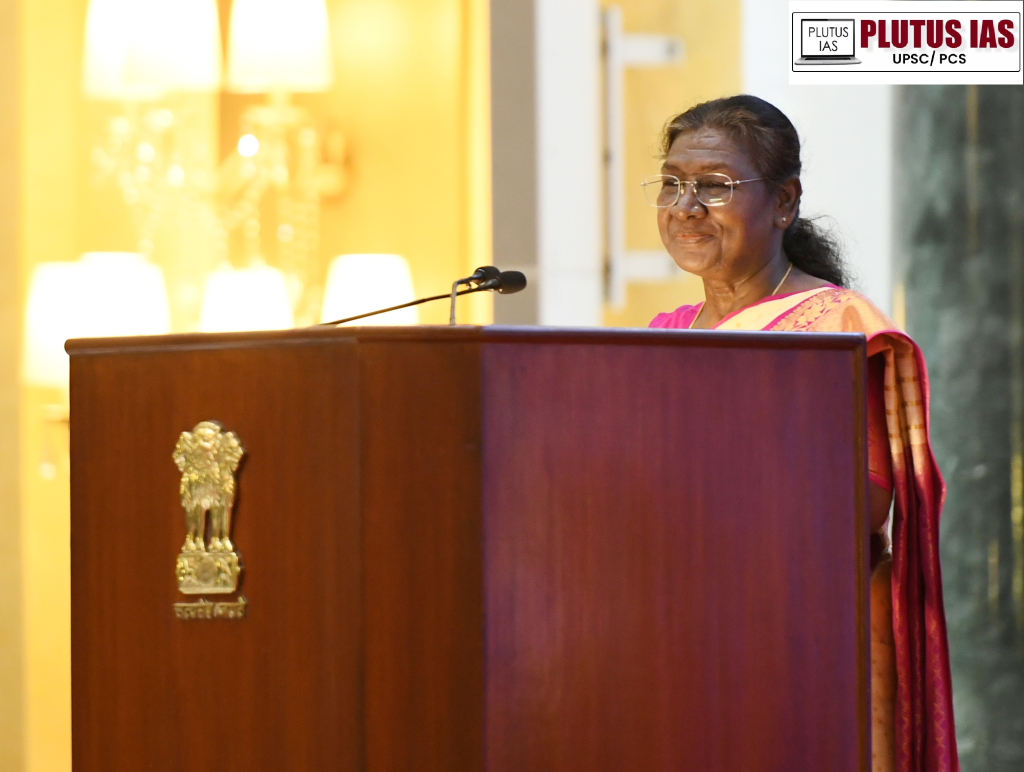07 Jan Empowering Tribal Communities: The Impact of the PESA Act
SYLLABUS MAPPING:
GS-2-Polity and Governance- Empowering Tribal Communities: The Impact of the PESA Act
FOR PRELIMS:
What is PESA and its salient features? what are the constitutional provisions related to PRI institutions and PESA?
FOR MAINS
What is the Panchayats (Extension to Scheduled Areas) Act (PESA), 1996? Highlight its key features and significance.
Why in the news?
This event is in the news because it highlights the significant role of women, particularly from Scheduled Tribes, in governance and community development through Panchayati Raj Institutions (PRIs). The meeting between the President of India, Smt. Droupadi Murmu and the women’s representatives mark an important step in recognizing and empowering women in rural India. The President’s address underscores the importance of PRIs in strengthening democracy at the grassroots level and their contribution to women’s empowerment. Additionally, the mention of 14 lakh women serving as elected members of PRIs, constituting 46% of total elected representatives, along with states increasing reservation limits to 50%, demonstrates a commitment to ensuring greater female participation in political decision-making.

What is PESA?
The Panchayats (Extension to Scheduled Areas) Act (PESA) of 1996 extends the provisions of the 73rd Constitutional Amendment, which governs Panchayati Raj, to tribal areas under the Fifth Schedule of the Indian Constitution. These areas, called Scheduled Areas, are primarily inhabited by tribal communities and are found in ten states: Andhra Pradesh, Chhattisgarh, Gujarat, Himachal Pradesh, Jharkhand, Madhya Pradesh, Maharashtra, Odisha, Rajasthan, and Telangana. PESA was introduced with certain exceptions to respect the distinct cultural and social characteristics of these communities.
Key Features and Goals of PESA:
1. Self-Governance for Tribal Communities: PESA empowers Gram Sabhas (village assemblies) to govern local affairs, ensuring that tribal communities manage their resources, such as minor forest produce, minerals, and water bodies, according to their customs and traditions.
2. Decentralized Decision-Making: The Act gives significant decision-making powers to Gram Sabhas and Panchayats, enabling them to oversee local development, select beneficiaries for government schemes, and approve projects based on community priorities.
3. Control Over Local Resources: PESA guarantees that tribal communities retain control over vital resources, protecting them from exploitation and displacement caused by large-scale development projects or land acquisition.
4. Implementation of Traditional Knowledge: The Act acknowledges the value of traditional knowledge systems, allowing them to guide development priorities and ensuring that the approach is culturally appropriate for tribal areas.
5. Protection of Tribal Rights: PESA acts as a safeguard against the erosion of tribal rights and access to resources, especially in the face of external development pressures.
6. Recognition of Local Customary Laws: The Act respects tribal customary laws and practices, making them an integral part of governance and conflict resolution within the communities.
7. Inclusive Development: By placing the decision-making power in the hands of local tribal populations, PESA aims to facilitate inclusive development that is aligned with their unique needs and aspirations, promoting sustainable and equitable growth.
Siginificanace of PESA:
1. Local Representation: PESA ensures Gram Sabhas (village assemblies) and Panchayats provide tribal communities with decision-making power over local resources and development.
2. Special Provisions for Tribal Areas: It adapts laws and policies to tribal customs, allowing local control over resources like forests, water bodies, and minor minerals.
3. Women Empowerment: In certain states, one-third of Panchayat seats are reserved for women, promoting gender equality in tribal governance.
4. One-Third Representation in Panchayats: PESA mandates one-third reservation for women in Panchayat elections, ensuring their participation in governance.
5. PESA Outside Tribal Areas: The principles of self-governance and resource management under PESA can be applied in non-tribal areas for broader governance reforms.
6. Regular Elections: PESA ensures regular elections in Panchayats, strengthening democratic governance and accountability in tribal regions.
Issues Related to PESA:
1. Lack of Institutional Support: There is insufficient infrastructure and institutional backing to implement PESA effectively. Many tribal areas lack the administrative framework and resources needed to fully support the Act’s provisions.
2. Lack of Awareness: A significant challenge is the lack of awareness among tribal communities about their rights under PESA. This limits their ability to engage with and benefit from the self-governance mechanisms the Act offers.
3. Bureaucratic Hurdles: Bureaucratic delays and resistance at various levels of government often slow down the implementation of PESA. Administrative red tape, insufficient coordination, and lack of political will can prevent timely and effective enforcement.
4. Delay in Framing PESA Rules: Many states have been slow in formulating PESA Rules, which are essential for the detailed implementation of the Act. Without these rules, local governance structures struggle to function properly.
5. Limited Empowerment of Gram Sabhas: While PESA empowers Gram Sabhas, in practice, local bodies often lack the authority or capacity to make impactful decisions. External influences and the persistence of traditional power structures undermine their autonomy.
6. Inconsistent Enforcement: Enforcement of PESA provisions is inconsistent across states, with some states failing to align their laws with the Act. This leads to mismatches in policy implementation, reducing its effectiveness.
Recommendations to empower PESA for real Panchayati Raj Institutions (PRIs) development:
1. Capacity Building:Governments should focus on training Panchayats to enhance their ability to plan and respond to citizens’ needs effectively.
2. Devolve Power: State leaders must devolve more authority to Panchayati Raj Institutions (PRIs), as mandated by the Constitution.
3. Build Planning and Evaluation Capacities:PRIs should be empowered as planners and evaluators, not just implementers of projects.
4. Elected Leaders Demand Control: Local leaders should unite with communities to demand greater autonomy and control over local governance.
5. Form Centres of Excellence:The Ministry of Panchayati Raj should create Centres of Excellence in universities to support PESA’s implementation with specialized training and research.
6. Participatory Planning:The People’s Plan Campaign should focus on participatory planning, resource convergence, and using advanced technologies for rural development.
7. Empower Women:The 73rd Constitutional Amendment ensures one-third representation for women in Panchayats, promoting gender equality and women’s involvement in decision-making.
Conclusion
PESA is a milestone legislation in India’s legal framework aimed at empowering tribal communities and ensuring inclusive governance. The key to its success lies in protecting its sanctity by implementing its provisions in both letter and spirit. This will ensure the achievement of its goal of inclusive development and empowerment, fostering democratic participation and safeguarding tribal rights and resources in India’s Scheduled Areas.
Download Plutus IAS Current Affairs (Eng) 07th Jan 2025
Prelims Question:
3. PESA mandates a one-third reservation for women in Panchayat elections in tribal areas.
How many of the statements given above are correct?
A. Only one
B. Only two
C. All three
D. NoneAnswer: B
Mains Question:
(250 words, 15 marks)




No Comments